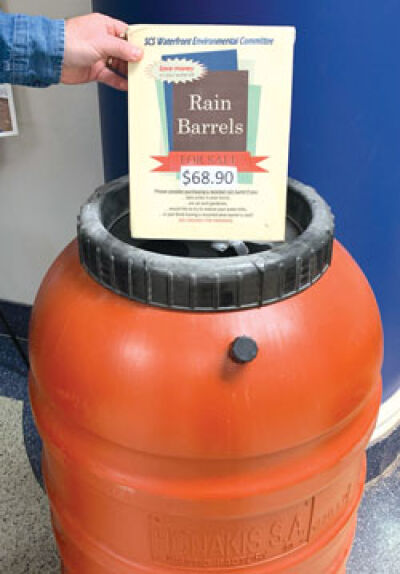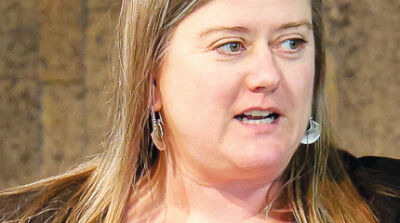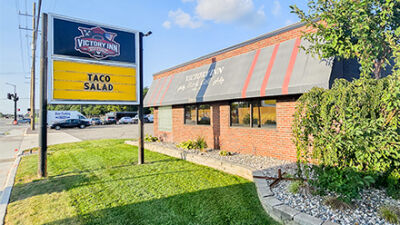
Mark Balon holds a sign showing the price of the rain barrels available for purchase at St. Clair Shores City Hall on Jefferson Avenue at 11 Mile Road.
Photo by Alyssa Ochss
METRO DETROIT — The quality of the water in Lake St. Clair and the Clinton River watershed continues to improve, according to officials and environmental groups, but the efforts to make it cleaner never stop.
St. Clair Shores is a part of the Clinton River watershed, which is another word for water basins or areas where water naturally collects and drains to one point, according to the Clinton River Watershed Council’s website. All water collected within the Clinton River watershed drains into Lake St. Clair in Harrison Township.
Other communities that are a part of the watershed include Rochester, Mount Clemens, Utica and many more. The watershed spans four counties, according to the website: Macomb, Oakland, St. Clair and Lapeer.
Macomb County Public Works Commissioner Candice S. Miller, a Macomb County native, former Harrison Township trustee and supervisor, Macomb County treasurer, Michigan secretary of state and U.S. representative who has long championed water quality initiatives, said, “The water quality in Lake St. Clair has dramatically improved in the last couple decades but we have a ways to go.”
She went on to say that Macomb is just one portion of the bigger picture. There are other counties that affect water quality, as does Canada across the river.
Miller said the biggest contributors to pollution are combined sewer overflows, or CSOs. She said money is being spent and projects are being created to prevent more combined sewer overflows from occurring.
One of the things being done is testing to make sure sanitary lines aren’t connected to storm drains. Miller said, in one case, they discovered an entire apartment complex with 25 units connected to a storm drain.
Mark Balon, chairman of the St. Clair Shores Waterfront Environmental Committee, said the lake is getting cleaner due to the help of city and state officials.
“I do believe it’s getting cleaner, primarily due to programs that Candice Miller has been doing around as a drain commissioner,” Balon said. “And the city of St. Clair Shores has been, I think, a good partner with her to be able to implement environmental programs in St. Clair Shores.”
The Waterfront Environmental Committee educates members of the community about their effect on the environment, especially Lake St. Clair, and what they can do to help reduce pollution. The committee hosts events such as highway cleanups, building rain gardens and coastal cleanups each year. Balon said he’s also helped school districts determine the best way to find cost effective and environmentally friendly building solutions.
“The Waterfront Environmental Committee is committed to the community to educate and bring awareness of environmental programs for future and the current generations,” Balon said.
Balon believes the most important thing people should learn about is storm drains. He said when things get caught in there such as leaves, chemicals and trash, those materials can get pumped to the lake. One example he used is fertilizer.
“People when they fertilize their lawns sometimes there’s some overspray, or their grass, a lot of water on their grass and the water will overflow into the street and go into the street and go down the drains,” Balon said. “And what occurs is fertilizer has phosphorus in it and other chemicals that then are pumped to the lake, and that gets entangled with the plants and it can kill fish if there’s a lot of high concentrations.”
Mike Gutow is the president of the Save Lake St. Clair Inc. nonprofit.
“Some areas have tried to make improvements, and I would say Macomb County is doing their best part to try to improve,” Gutow said. “Then again it is all relevant to the weather conditions for the year.”
If there is little rainfall, Gutow said, more of the pollution is going to show in Lake St. Clair because of the receding shoreline.
Save Lake St. Clair is an advocacy group that focuses on saving the lake through reducing pollution and raising their voices. The group helps enact new governmental policies. Gutow is also a founding member.
However, though there has been progress, Gutow said more could be done by other counties to stop the flow of pollution into the lake.
Gutow said the best city to look at in terms of replicating lake-saving procedures is Port Huron.
“The best point to look at is Port Huron; they no longer dump sewage into the lake like they used to,” Gutow said.
Gutow said it’s important to look at saving Lake St. Clair even if you don’t use it for recreational purposes.
“Even if you don’t recreate and use Lake St. Clair, this is the drinking water for 40% of Michigan,” Gutow said.
Gutow said the best thing to do to help with the upkeep of Lake St. Clair is to write to your representatives and make them aware of the issues of pollution and water quality.
 Publication select ▼
Publication select ▼


























